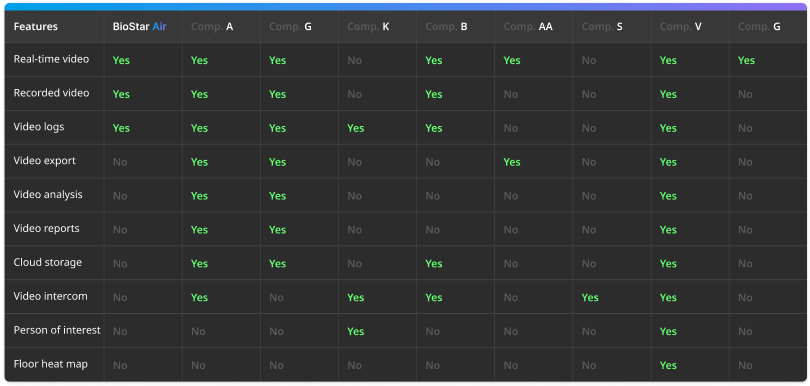- PRODUCTS
- Security Platform
- BioStar X | On-Prem SecurityNEW
- BioStar Air | Cloud Security
- BioStar 2
- Access Control
- Access Control Unit
- Biometric Readers
- RFID Readers
- Mobile Credential
- Peripherals
- Wireless Door Locks
- SOLUTIONS
- SUPPORT
- ABOUT
- device_hubHUB
- Blogs & Articles

After last week’s article, this is the sixth and last article in our cloud access control series, adapted from our latest eBook. If you want to dive deeper into the future of access technology, credential flexibility, and platform comparisons—download our full guide.
The market for cloud access control has matured significantly, with a wide range of solutions now available. While many providers offer cloud-based features, not all platforms are built the same—and the differences can have a big impact on deployment, usability, and scalability.
In the following article, we’ll compare some of the most common platforms across key areas like credential versatility, biometric integration, architecture, and video capabilities. Whether you’re evaluating solutions for your business or helping clients make the right decision, this guide is designed to provide a clear, practical overview of what each approach can offer.
Multi-credential flexibility.
Explore how top cloud access control systems support modern credential types, from mobile and QR to biometrics and Apple Wallet. See which platforms truly offer flexibility.

When it comes to credential flexibility, BioStar Air clearly leads the field. It’s the only platform that checks nearly every box, supporting everything from mobile and Apple Wallet to facial authentication, PIN, and app-less QR/Link Passes.
Some competitors also offer strong mobile and RFID support, and some support PIN or face credentials. However, they often lack newer, user-centric features like Apple Wallet integration, app-less credentials, or multi-credential setups that streamline access without app fatigue.
Verdict: BioStar Air stands out for its depth and flexibility, especially in mixed-use environments where different users require different ways to access a site.
Biometrics in the cloud.
Not all biometric access control is created equal. Compare platforms with native facial and fingerprint recognition.

BioStar Air delivers the most complete biometric experience in the cloud. It supports face and soon fingerprint, with fast 2-second onsite enrollment, enabling instant onboarding with high accuracy. It also features liveness detection, anti-spoofing, and the ability to authenticate users wearing , Biostar Air also bolsters a controller-free architecture, no separate door controller needed. This makes deployment faster, simpler, and more scalable.
Alcatraz AI delivers strong facial recognition with edge AI and effective liveness detection. However, the enrollment process is slower—typically requiring a 30-second scan—and while automatic enrollment is a promising feature, it takes multiple entries to calibrate properly, making onboarding less consistent. The system also depends on third-party readers and controllers, which adds integration complexity.
Brivo supports cloud-based face recognition but lacks flexibility. There’s no onsite enrollment, and setup requires admin-uploaded photos. It also needs a door controller, limiting deployment flexibility.
Verdict: BioStar Air leads in cloud-native biometric performance, with the fastest enrollment, broad credential support, and a tightly integrated platform designed for real-world use. Alcatraz AI is strong on facial recognition but comes with more hardware complexity. Brivo offers entry-level biometrics but falls short on key features that matter for usability at scale.
Video in the cloud.
Video is an essential part of modern access control, helping you verify access events, investigate incidents, and monitor sites remotely. But not every platform handles video the same way.

BioStar Air doesn’t aim to be a full VMS (Video Management System). Instead, it brings the most essential video tools right into your access control flow, without the complexity or licensing costs of full-scale surveillance platforms.
BioStar Air supports:
ㆍReal-time digital video via ONVIF-compatible IP cameras
ㆍRecorded video (on camera SD card) tied to access events
ㆍSearchable video logs and clips
ㆍAlerts and basic video reporting
Platforms like Verkada, Genetec, and Avigilon Alta offer deeper VMS functionality: analytics, cloud storage, AI-based person detection, and more. That makes them ideal for organizations with dedicated security operations and full-time monitoring needs.
But for leaner teams or those who want door-centric visibility without a full CCTV deployment, BioStar Air offers a clean, integrated, and easy-to-use solution.
Verdict: If you need heatmaps, AI tagging, and forensic search, go with a VMS-focused platform. But if your priority is quick visibility at the point of entry—tied to access events—BioStar Air delivers the right level of video integration without the overhead. It’s a smart balance for coworking spaces, education, retail, and growing multi-site operations.
Overall.

In a cloud market filled with similar claims, the real test comes down to execution, especially at the door. BioStar Air scores high where it counts: in credential flexibility, biometric readiness, and architectural simplicity.
While some competitors outperform on video or alarm management (like Verkada and Genetec), most struggle with deeper biometric integration or edge-level innovation. BioStar Air stands out with native biometric support in the cloud, smart edge architecture, and support for app-less, mobile, and facial credentials, creating a user-first experience with lower infrastructure demands.
The tradeoff? BioStar Air’s current video features are still lightweight (currently in beta), favoring door-centric simplicity over full-blown VMS capabilities. But for teams focused on access, not surveillance, that’s often a strength, not a weakness.
Verdict: BioStar Air leads in modern, flexible access control, especially for environments where fast enrollment, cloud-native biometrics, and frictionless scaling matter most.
This wraps up our cloud access control series, but the conversation is just beginning. As the industry moves toward more scalable, user-first systems, knowing how platforms compare is more critical than ever. If you want the full breakdown, plus use cases, architectural deep dives, and expert insights, download the full BioStar Air eBook.











